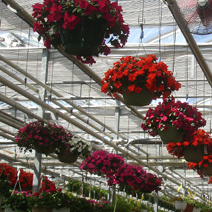Supplemental Lighting Considerations for a Commercial Greenhouse
Maximizing lighting efficiency is a major concern for many growers who rely on supplemental lighting in their greenhouse. Here are some criteria to take into account when choosing and maintaining your lamps. The lighting you choose depends on many things like what developmental stage your plants will be grown to, whether the plants receive light from other radiation sources, and the photoperiod length per day for your plant.
Choosing the Right Spectrum for your Needs
When choosing a lighting system, specific requirements may be imposed on the light spectrum by the type of plant being grown, the stages to which it will be grown, plus any additional needs of the grower (e.g. desire for a shorter plant height). All plants require PAR light (Photosynthetically Active Radiation), and this type of radiation is within the 400 to 700nm wavelength range.
Light Level Requirements
The light level target required for any particular plant can be determined from known light requirements based on scientific studies (e.g. full sun, partial sun, shade, etc). Supplemental light levels need to be only a fraction of complete light levels, while photoperiodic light levels can be even lower. Greenhouse systems companies such as GGS Structures have advanced tools that can precisely measure the natural light levels in your greenhouse, as well as the light levels produced by your supplemental lighting.

Our Sales Manager Michael adjusting the light controls.
Checking the Shadow Area of the Fixture
As with any hanging object in your greenhouse, a light fixture will cast a shadow. You need to ensure that natural light is not being blocked in critical areas of your benches – an issue which your lighting designer should consider when planning the layout.
What is the Efficiency of the Fixture?
Energy costs are the number one expense in a greenhouse. Lighting can take take up a significant portion of these costs. As with any energy upgrade cost, you need to weigh the initial upfront investment against the potential payback. Most greenhouse systems companies can calculate this payback for you, and inform you of how many years it will take to recover your costs. LED lights require a larger upfront investment but use substantially less energy than HPS lights.
 What are the Electricity Requirements?
What are the Electricity Requirements?
An often overlooked expense is whether or not your greenhouse has the electrical configuration needed to power your supplemental lighting. Your wiring, breaker boxes, and amps of service are all factors that should be considered.
Are there any Rebates Available?
Energy rebates are always something to look for when installing new supplemental lighting. You may qualify for rebates from your local utility, or for efficient energy upgrade programs provided by the USDA or other organizations.
With all the considerations above, GGS can help you choose the right lighting equipment to fully optimize the growth of your plants. We have partnered with lighting supplier Illumitex to provide growers with industry-leading lighting products.







